The art of gardening: Cultivating the backdrop to Chihuly in the Botanic Garden
Dale Chihuly’s magnificently formed artworks are breathtakingly sublime. When the event ends, their presentation will have seen more than 18 months’ work by the Botanic Gardens’ team – including an upcoming conga line.

Dr Leonie Scriven is on the home stretch of Chihuly in the Botanic Garden, with packdown just weeks away.
As Deputy Director, Living Collections, she has been integral in the presentation of Dale Chihuly’s Garden Cycle exhibition, an Australian first and a coup for the Adelaide Botanic Garden.
The display of Chihuly’s vibrant, large-scale artworks has seen more than 5000 new plants added across the 24 installations, but the work began much earlier.
In September 2023, the Chihuly Studio visited and worked with the Botanic Gardens team to select preferred sites for the installations, giving consideration to landscape, vista and sight lines, artwork colour and form, plant and landscape textures, as well as visitor flow through the garden.
The horticultural team began researching and sourcing plants nine months out from the installation period, producing landscape mood boards for consideration by the Chihuly Studio and Dale Chihuly.
“We’d meet regularly by video calls, refining the plant palette until we created the final effect we both wanted,” said Scriven.
“The colour palettes and textures provided by leaves and or flowers were often selected to either complement or exaggerate the colour of the glass installations.”
Other factors in plant selection for Chihuly in the Botanic Garden were each site’s environmental conditions, and whether the artworks were in a new or existing Botanic Garden living collection display bed, like the Cattails and Copper Birch Reeds (2024) in the Economic Garden.
This resulted in a mix of natives and exotics being used together.
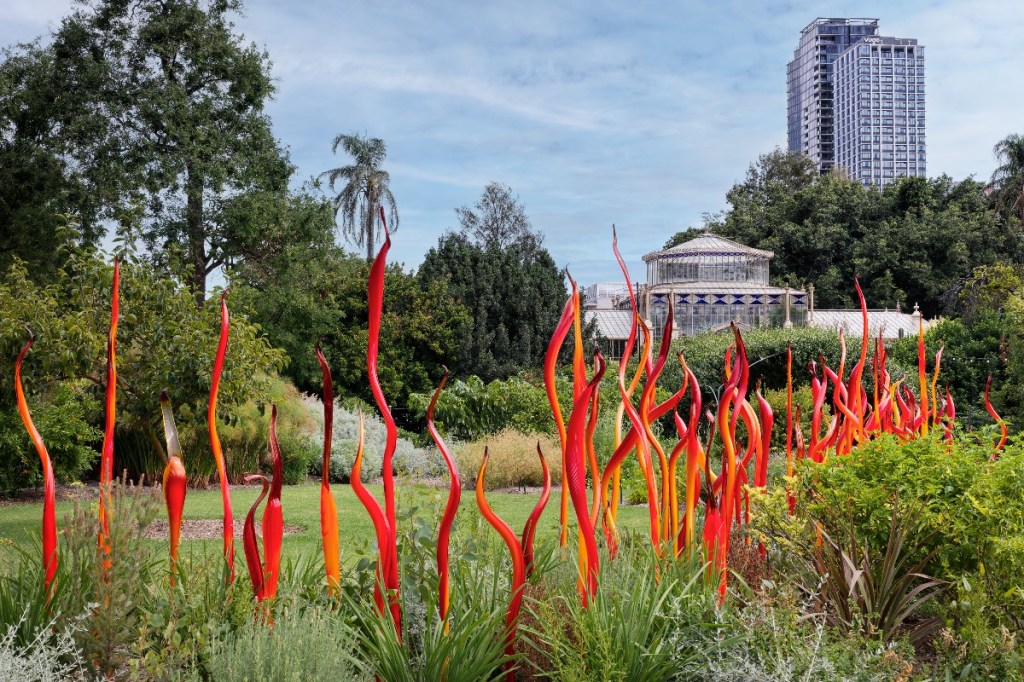
Australian native species used include Westringia fruticosa ‘Smokey’; Pennisetum alopecuroides ‘Nafray’; Carex ‘Feather Falls’; Cordylines; Juncus pallidus, Isolepis nodosa; Lomandra ‘Lime Tough’; Dianella ‘Tas Red’; Blechnum; Asplenium nidus’; Waterhousea floribunda; and Eucalyptus saligna.
Non-Australian native species – plants, which while not native to Australia, have established a self-sustaining population – include Leucadendron salignum ‘Cheeky’; Euphorbia milli x Hybrid Lipstick; Cotyledon macrantha ‘Kermit’; Salvia muirii; and Liriope muscari ‘Emerald Cascade’.
Scriven said these were sourced locally from Heynes Wholesale Nursery, Coromandel Native Nursery and State Flora, and the team had contingency plans in case of small hiccups.
You might like
“We sourced additional replacement stock to cover individual plant death,” she said.
“Generally, we had a very high success rate with each of the selected species, which speaks to the high standard of horticultural practice and quality of plants we were working with.”
Some of the new beds replaced long-standing turfed areas and required additional preparation.
Planting density was generally much higher than used for normal bedding to ensure robust displays for the exhibition catalogue, which was shot during the early installation period in September.
However, that abundance and quality was, temporarily, a magnet for the local wildlife.
“Several of the new plantings were eaten by rabbits a day after planting,” said Scriven.
The horticulture team replaced the munched plants and used temporary fencing to protect the new ones until they were large enough to withstand the invaders.
Native plants are very versatile with the right soil and site preparation, said Scriven, making them effective companions to Chihuly’s artistic style.
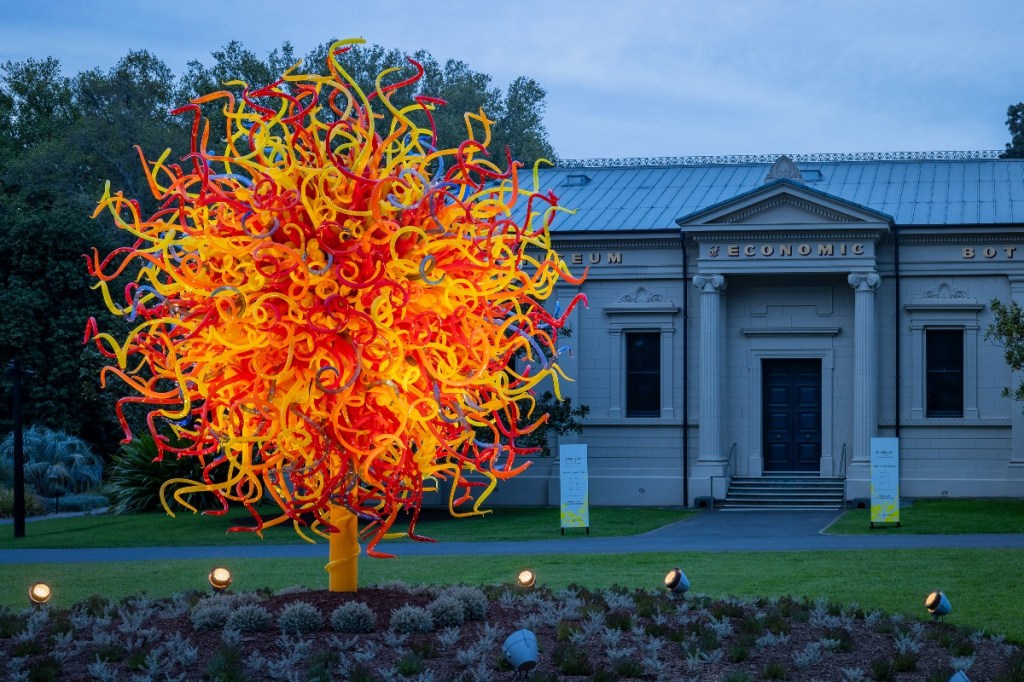
The soft green-grey foliage of coastal rosemary or Westringia fruticose ‘Smokey’ was used to highlight the blue glass in The Sun (2014).
The succulent Cotyledon macrantha ‘Kermit’ with its large, glossy leaves reflected the colours of Vivid Lime Icicle Tower (2022) under which it was planted.
While the texture of the nearby tufts of foxtail grass or Pennisetum alopecuroides ‘Nafray’ cultivar enhanced the Red Reeds on Logs (2024).
Texture was also used to great effect in mass monochromatic plantings, such as the Euphorbia milli x Hybrid Lipstick under the Glacier Ice and Lapis Chandelier (2024) hanging in the Palm House.
“And of course, the beautiful pink lotus water lily flowers were a natural highlight to the Blue Crystal Tower (2024), located within the Nelumbo Pond,” said Scriven.
“The time between project commencement and actual planting days was very tight, and everything needed to be ready for the Chihuly Studio installers to work as soon as they arrived in September.”
At times, more than ten people were working in a garden bed, with project delivery schedules planned down to the half day.
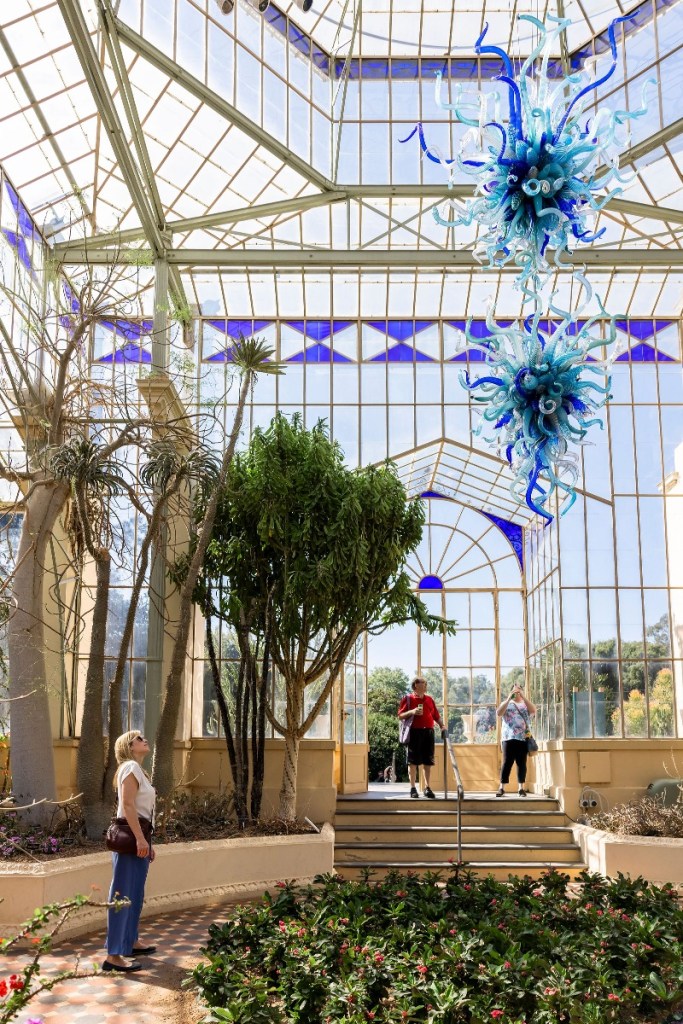
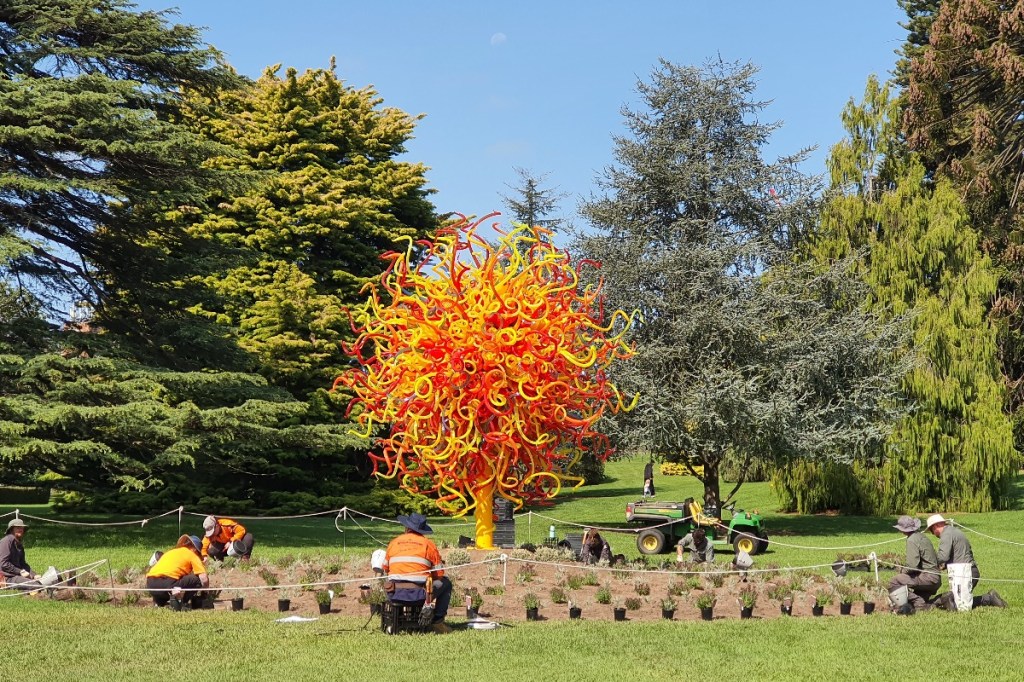
“Each artwork required a different display, some needed to be not too showy, others to cover large concrete support plinths, hide lighting and create a physical barrier between the observer and the artwork.”
Obtaining bulk plant material for use also presented some challenges but the team worked with local nurseries to secure supplies.
All up, 37 truckloads of mulch were placed over an eight-week period, along with six semi-truck loads of loam and one semi-truckload of pebble and rock.
The works were done during visitor open hours, meaning access to the site and the safety of staff and interested visitors watching also had to be managed.
There were additional considerations, in terms of horticultural design, for some of the artworks, including those in the First Creek Wetland ponds.
“The pond’s surrounding plantings were new, but we had to leave a space for the Chihuly Studio installers to access the water by boat and walk in to place the glass, so a staged approach of plantings was used,” said Scriven.
For Sapphire Star (2010), a raised edge garden bed was created due to its location in an overland swale channelling stormwater runoff through the gardens.
The Eucalyptus saligna logs for Red Reeds on Logs (2024) were sourced internally and from the Mount Lofty and Wittunga Botanic Gardens.
The garden’s staff were tasked with cleaning the glass artworks every two weeks, to ensure they remained free from dust and algae.
For artworks in or on the water, this meant working from inflatable kayaks, while taller installations called for microfibre cloths attached to extension poles.
The Bicentennial Conservatory saw a “real blitz of work” to prepare the landscape for the installation of Chihuly’s artworks, said Scriven.
Once they were in, daily maintenance and the occasional trim of the large palm fronds ensured nothing fell on the precious artworks.
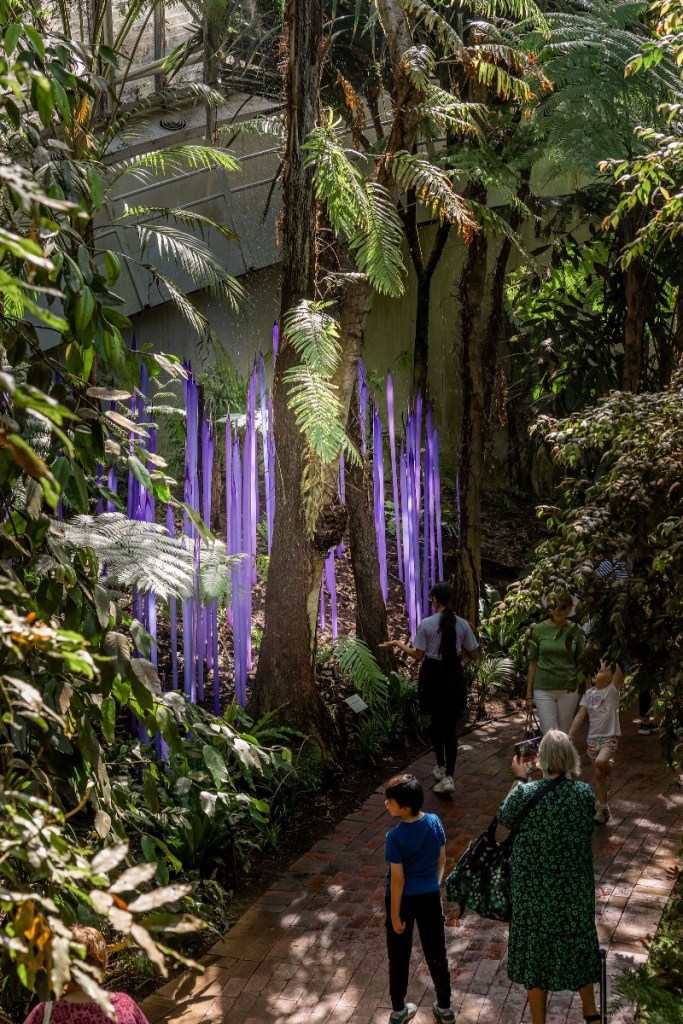
“The Bicentennial Conservatory is a special place, housing many sensitive temperate rainforest species, so working amongst the collections was challenging but worthwhile,” said Scriven.
When Chihuly in the Botanic Garden closes after its seven-month run, it will have seen more than 1.2 million people walk through the North Terrace gates.
The event has allowed the nursery team to trial growing native species in large display tubs.
Among the plants lining the boulevard of the main entrance is Swainsona formosa, Sturt’s Desert Pea – a nod to state pride and a greeting to the hundreds of thousands of interstate visitors who have seen the exhibition.
Packdown will see some of the plants in the newly created garden beds replanted elsewhere in the Adelaide Botanic Garden.
“We have Living Collection Polices and Plans and the plants must meet the requirements of those strategic documents,” said Scriven.
They will be moved en masse as part of the decommissioning process in May.
“The horticultural staff will effectively form a conga line, with some carefully removing each plant, others transporting the plants and another team at the new location planting them.
“Should be an interesting sight for visitors over the three most intensive days!”
After a year and a half working on the event, Scriven said Adelaide Botanic Garden has become “a centre of learning” for event horticulture within a botanic garden, with a multitude of new processes and documents created to assist the effective, efficient and safe delivery of site preparation and activation to support major events.
Now it is almost over, Scriven said her team is looking forward to hanging up their microfibre cloths.
“But honestly, we’ll all miss Chihuly in the Botanic Garden – it’s been a wonderful experience for our teams, for the state and for visitors.
“It has been such a pleasure and privilege to work with the Chihuly Studio and all our generous partners who have supported the Botanic Gardens throughout the exhibition.”











